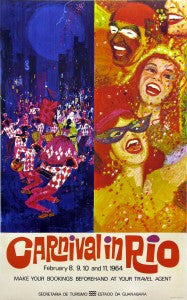Your Cart is Empty
 For 40 years Poster Plus has carried a wide variety of Original Vintage Posters. From 1890's European advertising to American Travel Posters. From WPA, World War Propaganda, and Circus Posters to Artist exhibitions. We invite you to visit our gallery or browse our extensive collection online.
For 40 years Poster Plus has carried a wide variety of Original Vintage Posters. From 1890's European advertising to American Travel Posters. From WPA, World War Propaganda, and Circus Posters to Artist exhibitions. We invite you to visit our gallery or browse our extensive collection online.
The modern history of posters began with Jules Cheret, who in the 1850's revolutionized the lithography printing technique by adding color. The poster as an advertising vehicle quickly spread from France throughout Europe and to the US. The drab broadsides with an overabundance of type were replaced with bright colors and often scantily clad women inviting the viewer to go to the Folies Bergere, to buy Absinthe Robette, or to shop for clothing, perfume or biscuits. It quickly became known as the art of the streets, and collecting was so widespread in the 1890's that one could buy a Toulouse-Lautrec poster in Paris or Chicago.
In the United States, poster advertising exploded in the 1890's with Harper's and other popular magazines issuing monthly posters. Circuses such as Ringling Brothers or Barnum & Bailey preceded their arrival in towns all across the country with posters plastered on every vacant wall. World Wars I and II led to the use of the poster as a propaganda tool; posters encouraged citizens to enlist, conserve, produce and buy bonds.
Posters as advertising messages declined after WWII with the use of color in periodicals and television. Posters were truly ephemeral pieces of paper. They were pasted over, torn down and discarded when the event or campaign ended. It is a testament to their beauty, interest and cultural value that some few survived. Throughout the periods of poster production collectors obtained the latest designs by bribing the workers pasting up the posters, tearing the posters off a wall, or by purchasing them from the publisher or specialty shops.
Collecting as a passion or hobby has gone through several periods of intense interest. During the "poster craze" of the 1890's large private collections were assembled in Europe and the US. The patriotism of the two World Wars led to collecting once again. Today, people all over the world are not only collecting vintage posters but are for the first time displaying them in their homes and offices. Corporations are buying back posters they once discarded. Museums are discovering posters in their dusty storerooms and putting them on display. These activities and the last 30 years of ever-increasing interest confirm that posters are gaining recognition not only as wonderful decorative objects, but also as important artistic and cultural artifacts.